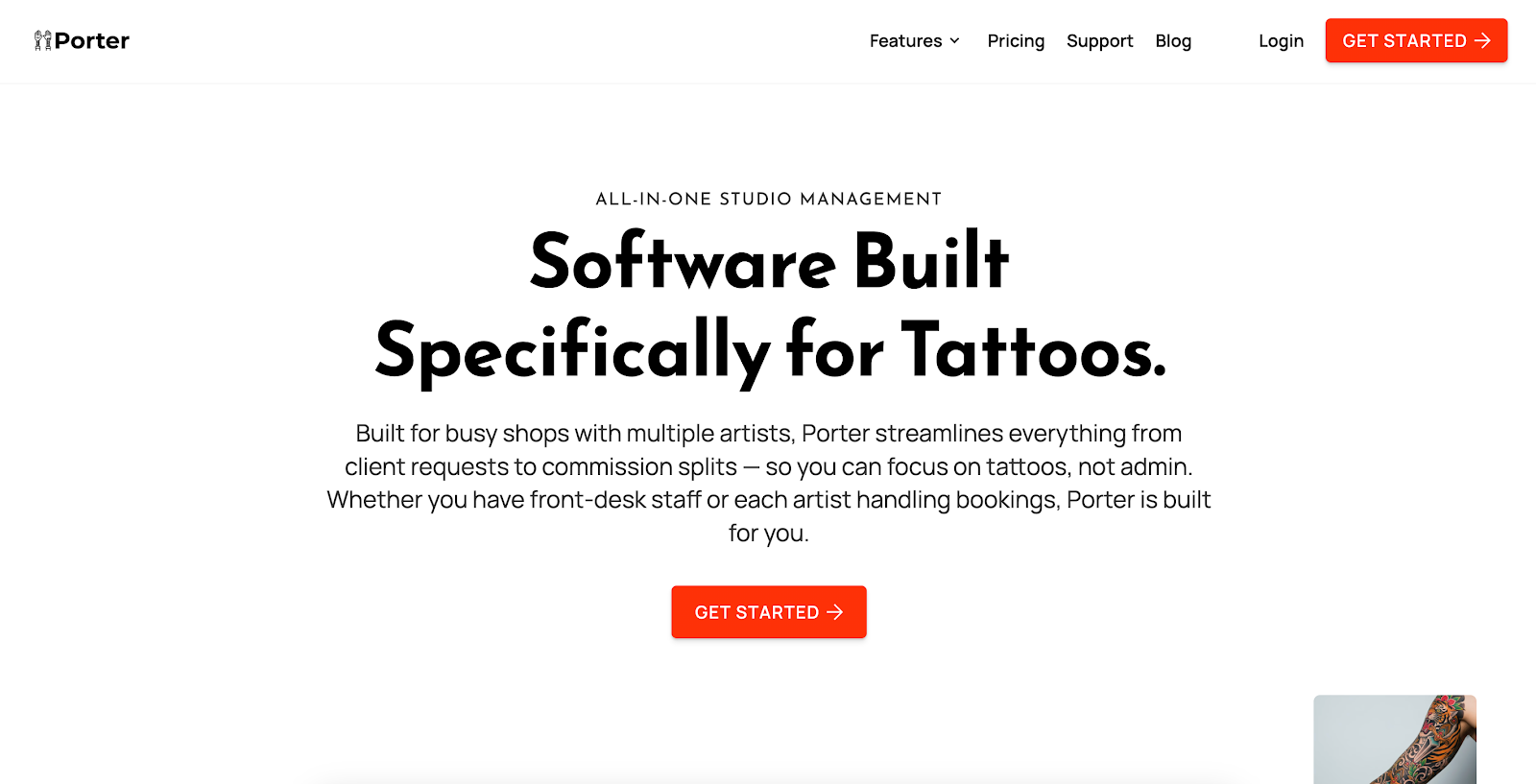Modern tattooing involves more than simple machines and paper sketches. Tattoo technology has transformed every aspect of the process, from design creation to appointment scheduling and payment processing.
These advancements bring several benefits to artists and shop owners. They improve daily tasks, reduce health risks, and give clients a smoother tattooing experience.
This article lists the most popular technological advancements you can use to stay current with industry innovations and grow your tattoo business.
1. AI-Powered Tattoo Design and Editing Software
AI-powered tattoo design tools make it easy to develop ideas and share them with clients. Instead of spending hours sketching by hand, artificial intelligence creates custom tattoo designs quickly based on client preferences.
All you need to do is share a short text prompt. The software can instantly adjust styles, resize artwork, and even show how a piece will look on different parts of the body.
This saves time during consultations, which means you can accept more bookings and get more revenue.
AI software is not meant to replace the art created by talented tattoo artists. Instead, it merely works as a supportive tool that helps improve client communication.
2. 3D Scanning and Modeling
3D scanning and modeling give clients a realistic preview of how their tattoo will look on their body before ink application.
By mapping the skin’s surface, this technology helps you change size, placement, and flow so the design fits naturally.
It also matches a specific pattern to the natural shape of the body. This ensures the accuracy that flat sketches can’t provide.
With 3D tools, you can even overlay a reference tattoo image directly onto a virtual model of the client. This builds trust and helps your tattoo shop deliver professional results every time.
Some modern tattoo studios go further by exploring 3D printers, which print designs directly onto prosthetic limbs for placement and size accuracy. They also create intricate tattoo machines and other accessories.
3. Tattoo Studio Management Software
Tired of juggling DMs, spreadsheets, and endless back-and-forth messaging? Tattoo studio management software simplifies how you manage your shop while allowing artists to focus more on their craft.
Thanks to built-in online booking, clients can see artist availability and schedule a session anytime without waiting for a reply. They can fill out a tattoo appointment form, submit personal details, and upload reference photos.
Once the appointment is confirmed, the system sends automated reminders to reduce no-shows. These can save both time and money.
Many platforms also collect deposits, payments, and client history in one place. On top of that, detailed reports and analytics provide insights into total sales, booking utilization, and client conversion rates.
Studio management software is a game-changer for many tattoo artists and shop owners. This technology keeps daily operations organized, efficient, and client-friendly.

4. Wireless and Modern Tattoo Machines
Tattooing tools have come a long way. New tattoo machines are now designed for speed, comfort, and precision.
One of the biggest upgrades in recent years is wireless technology, which removes the need for cables and power supplies cluttering your station. This freedom gives you more precision, movement, and control, especially during long sessions.
Many intricate tattoo machines also feature adjustable speed settings, lightweight designs, and longer battery life, making them easier on your hands and wrists.
Investing in wireless and modern tattoo machines can boost efficiency and client satisfaction.
5. Smart Needles
Smart needles are among the latest advancements in tattoo technology, which are designed for safety and greater precision.
Smart needles come in two main types: modern tattoo needle cartridges and biosensing needles.
Needle cartridges are designed for quick changes, which lets you switch between linework and shading without pausing the session. They also reduce contamination risks, which improves studio hygiene.
Bio-sensing needles are still in development, but they're designed to be health monitors for serious medical conditions. They are usually made with functional materials that respond to vital signs.
Some researchers also study non-needle methods for delivering ink, such as ultrafast liquid jets. This approach may lessen pain compared to traditional, large needles. It's a good choice for customers who want a painless tattoo.
Bloodless tattoos are also possible through microneedle technology developed by the Georgia Tech team led by Mark Prausnitz. These microneedle tattoos are made of tattoo ink encased in a dissolvable matrix.
6. Temporary or Glow-in-the-Dark Tattoo Inks
Not every client wants a lifelong and permanent design. This is where temporary tattoo inks and glow-in-the-dark pigments come in.
Temporary inks fade over time, giving clients the chance to experiment with body art before committing to something permanent. This appeals to younger clients or those unsure about long-term tattoos.
On the other hand, glow-in-the-dark inks add a fun and modern twist, especially for nightlife or special events. These pigments are nearly invisible in daylight, but they glow under ultraviolet light.

For studio owners, offering these options can help you get more tattoo clients, increase revenue, and set your studio apart from competitors. It’s a simple way to expand services while meeting growing client demand for variety.
7. Tattoo Sterilization Technology
Keeping equipment clean is one of the most important parts of the tattoo process. Modern sterilization technology goes beyond traditional methods by using UV sanitizers and advanced autoclaves to keep equipment safe.
These tools reduce the risk of cross-contamination, which protects both your clients and tattoo artists.
Investing in tattoo sterilization technology shows a clear commitment to safety and professionalism. It also improves clients' trust and comfort, knowing their well-being comes first.
8. Payment and E-Commerce Integrations
In modern times, cash-only payments can drive clients away. A tattoo POS system helps you handle card payments, deposits, and receipts in one place.
Many platforms also send checkout links directly to customers. These allow them to pay via card, Apple Pay, Google Pay, or saved cards on file without the need for hardware.
Another growing tattoo innovation is buy-now-pay-later (BNPL) services. With BNPL, clients can split the cost of larger tattoo sessions into smaller payments, making high-value work more affordable.
Beyond payments, e-commerce integrations allow you to sell aftercare products, gift cards, or merchandise directly through your website or social media accounts. These provide additional revenue streams and smoother client experiences.

9. Non-Invasive Tattoo Removal Technology
Traditional tattoo removal often involves lasers, long healing times, and a painful process.
New non-invasive tattoo removal methods are designed to be gentler on the skin. They often use techniques like advanced chemical solutions and laser alternatives that break down old tattoos with less damage.
They suit clients who change their minds about a design or want adjustments before their final tattoo is applied. They also open the door for correcting or removing cosmetic tattoos, such as eyebrows or eyeliner.
Since non-invasive tattoo removal methods are less aggressive, you can use them as another service option to attract clients.
Tattoo Industry Trends to Watch Out for in the Future
Here are the emerging trends and exciting developments in the tattoo industry.
Robotics
Robotic tattoo machines are being tested to improve precision and consistency. While they won’t replace human artistry, they may help with repetitive designs.
These allow your tattoo artists to work faster with less strain. That means you can book more appointments in a day, which can boost daily revenue.
Eco-Friendly Practices
Clients are increasingly asking studios to adopt eco-friendly practices. This includes switching to biodegradable needles, using plant-based inks, and reducing plastic use.
Tattoo shops that highlight sustainable practices meet this client demand and build a reputation as responsible businesses.
Implementing green solutions can also lower waste, attract environmentally conscious clients, and set you apart in a competitive market.
Medical Tattoos
Medical tattoos are gaining recognition as tools for recovery and confidence. These can include scar camouflage and procedures that restore nipples for clients who have undergone breast surgery.
Beyond cosmetic and permanent makeup uses, new research studies the use of a microneedle patch to deliver medication or track health conditions. This trend highlights how tattoos could serve both artistic and medical purposes.
Consider learning these skills to expand tattoo services and offer meaningful support to clients in need.
Customization Through Digital Platforms
Digital technology, like augmented reality (AR) and virtual reality (VR), gives clients more control over their designs.
Clients can preview tattoos on their skin through AR apps or explore design concepts in immersive VR environments. This makes consultations faster and more interactive.
It also reduces uncertainty, helping clients feel confident about placement, style, and size before the session begins.
Cultural and Heritage Tattoo Art
Tattooing has deep roots across many cultures, and there is a growing interest in reviving and honoring these traditional methods.
From Polynesian tribal work to Japanese irezumi, clients are seeking designs that connect with heritage and identity.
Respectful use of this artistic trend can help your shop appeal to diverse audiences. At the same time, it shows authenticity and care in honoring traditions that shape tattoo history.
Porter Is the Best Tattoo Technology for Studio Management

Porter puts your studio’s entire workflow into one powerful technology solution built just for tattoo artists and shop owners. It handles booking, payments, POS, CRM, and analytics in one place. You no longer need to juggle DMs, spreadsheets, and scattered apps.
With Porter, your clients can book directly from your Instagram, website, or any digital channel. You can collect deposits and send automated reminders to reduce no-shows.
Porter's hardware POS is tightly integrated with scheduling to ensure a smooth checkout experience. It also sends checkout links and automated receipts so you get paid quickly.
On top of these features, Porter offers BNPL services, marketing tools, review management capabilities, and funding to help grow your business.
FAQs About Tattoo Technology
What technology do tattoo artists use?
Tattoo artists rely on advanced machines, smart needles, and digital design software to create precise work. Many also use studio management systems for scheduling and payments.
These technological advancements make it easier to focus on the beauty created through tattooing while business operations run smoothly.
Has tattoo technology improved?
Yes, tattoo technology has improved greatly. Modern inks work better on different skin tones, while new sterilization systems reduce risks of allergic reactions and infection.
Technological tools give artists more accuracy and clients more confidence in their designs and tattoo experience.
What is the 1/3 rule tattoo?
The 1/3 rule refers to a design principle where a tattoo covers about one-third of a visible area, which creates balance without overwhelming the body. It helps clients decide on placement and size.
This guideline is often shared by other artists when advising clients about proportion and flow.



.avif)



